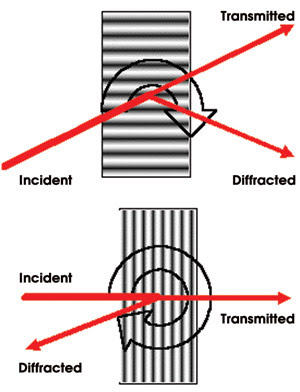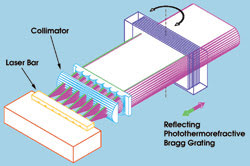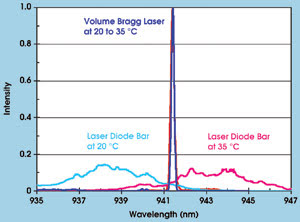Dr. Leonid B. Glebov, University of Central Florida, Center for Research and Education in Optics and Lasers
The stated goal of the Super High Efficiency Diode Sources (SHEDS) program is to develop superefficient diode lasers, which, in turn, will lead to efficient, high-power solid-state lasers. The missing link between these two goals is the spectral match between the diode laser pump and the solid-state laser, and it is on realizing that match that we are focusing our efforts.
A spectral width above 5 nm and drift of the diode laser’s wavelength with temperature — roughly 0.3 nm/K — can introduce a significant mismatch and undermine the efficiency enhancements generated in other parts of the SHEDS program. The work in Michael Bass’s laboratory indicates that the pump bandwidth should be no more than a couple of nanometers to maximize pumping efficiency. Thus, we are attempting to minimize the bandwidth of high-power diode lasers and to stabilize their wavelength with respect to temperature changes at a position that provides optimal distribution of absorbed energy in a gain medium.
Our approach is to use an external resonator with dispersive elements, a concept that has been on the table for at least a quarter century. The external resonator provides narrowband feedback at a stable wavelength, forcing the laser to have those same spectral characteristics. Until now, however, the utility of this approach had been restrained by the absence of robust dispersive elements that combine high spectral selectivity and stability when subjected to tough thermal, mechanical and optical conditions. The situation was dramatically changed by our development of high-efficiency volume diffractive elements (Bragg gratings) in a photothermorefractive glass.
As the name implies, a photothermorefractive glass is one whose refractive index can be selectively modified by combined photonic and thermal processes. Our material is a Na2O-ZnO-Al2O3-SiO2 glass doped with silver, cerium and fluorine. Its photosensitivity is between 280 and 350 nm, so several commercial lasers — HeCd, argon-ion or N2 — can write in it. The UV exposure is followed by thermal development at approximately 500 °C, which results in refractive index decrement of approximately 10–3 in the regions exposed to the UV radiation. This use of a two-step recording process ensures that patterns written in the material cannot be erased or distorted by heating below 400 °C or by any type of optical or ionizing radiation.
Photothermorefractive glass is an ideal medium for the diffractive dispersive element in an external resonator stabilizing a diode laser. It has virtually no absorption from 400 to 2500 nm, and its damage threshold is approximately 40J/cm2 for 8-ns pulses at 1064 nm and exceeds 100 kW/cm2 for CW irradiation at 1085 nm. The linear refractive index and the dispersion of photothermorefractive glass in the near-IR are typical for crown glasses (n0.8 = 1.49, νd = 59.4), the thermal derivative of refractive index is almost zero (dn/dT = 10–7/K), the thermal shift of Bragg wavelength caused by thermal expansion is small (dλ/dT = 7 pm/K), and its nonlinear refractive index is the same as for fused silica (n2 = 3.3 × 10–16 cm2/W).

Figure 1. The bulk Bragg gratings can reflect or transmit the diffracted beam. When used as the dispersive element in a laser diode’s external resonator, they are designed to refract a narrow band of wavelengths directly backward.
We can produce either reflective or transmissive gratings for almost any geometry for the input and output beams (Figure 1). Unlike conventional surface gratings (both ruled and holographic), thick Bragg gratings diffract only one wavelength for any incident angle.
This means that for all other wavelengths approaching the grating at this incident angle — and for this wavelength approaching the grating at other incident angles — the grating is a transparent glass plate. Spectral selectivity in the near-IR region ranges from 10 to 0.1 nm, and selectivity down to 0.01 nm can be expected in the near future. The best diffraction efficiency for these gratings exceeds 99 percent, while insertion loss is less than 2 percent (0.1 dB).

Figure 2. The photothermorefractive Bragg grating serves as the output coupler. Because it reflects only a narrow band back into the laser, the laser can lase only within that band.
We have deployed a photothermorefractive grating as the output coupler of each laser in a monolithic laser bar (Figure 2). The spectra of this multichannel volume Bragg laser, and of a corresponding laser bar without the external resonator, are shown in Figure 3. Without the external resonator — that is, when the two end facets of the diode formed the laser resonator — the laser’s bandwidth was somewhat more than 5 nm, and the output shifted by approximately 5 nm as the laser’s temperature varied from 20 to 35 °C. When the photothermorefractive grating was substituted as the output coupler, the bandwidth was reduced to approximately 0.2 nm, and thermal shift in the output wavelength was imperceptible.

Figure 3. The laser’s output spectrum is narrowed from ~5 to ~0.2 nm with the addition of the photothermorefractive Bragg grating in the external resonator. Moreover, the output wavelength was locked at ~941 nm, virtually independent of temperature.
The external resonator reduces the laser’s efficiency by about 5 percent, and one of our challenges in the SHEDS program is to cut this efficiency loss to something in the neighborhood of 2 percent. We have observed performance similar to that in Figure 3 in many laser diode bars produced by our colleagues from Alfalight Inc. of Madison, Wis., and nLight of Vancouver, Wash.
Thus, photothermorefractive volume Bragg gratings have shown undoubted success for the efficient spectral stabilization of semiconductor laser and laser bars.
Meet the author
Leonid B. Glebov is a senior research scientist at the College of Optics and Photonics/Center for Research and Education in Optics and Lasers at the University of Central Florida in Orlando; e-mail: [email protected].